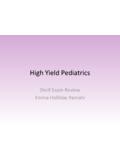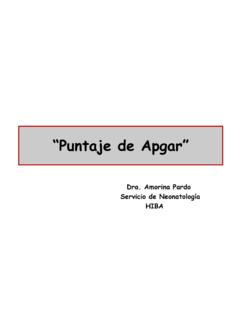Transcription of Alpha1-Fetoprotein (AFP) Reference Values in …
1 ALPHA,- fetoprotein (AFP) Reference Values IN INFANTS UP TO 2 YEARS OF AGE M. E. C. Blohm, MD, D. Vesterling-Horner, MD, C. Calaminus, MD, and U. Gobel, MD Department of Paediatric Haematology and Oncology, Children s Hospital, Heinrich Heine University Medical Centre, Dussrldorf, Germany The azm of thzc tludy wac to pstablzsh Reference Values andjktorr atsocaated wzth smm AFP rlevatzon in znfantc Fzve hundrrd twentyfour samples collerkd from infants up to the age of 2 years at the Unzversity Hospzlal DUSSQ~~O$ (Germany) were analyzpd At birth mean cmm AFP levels were 41,687 ng/ml zn 256 term Oabzes and 158,125 ng/ml zn 90 premature babzrc born before the 37th geslalzonal week, excludzng samples from chzldren wzth factors known to b~ ass@ czatrd utzth AFP elp(m/taon.)
2 In thpjirst 4 weeks oflzfr, AFP hrls derreated by 50% in dqr zn tprm babzrc Betwpen day 180 and 720 oflfe, AFP levels up to 87 ng/ml were iuzthzn the % zrilerual (acsumed loganthmzr normal dzstnbutzon) wzth a mean of 8 ng/ml wzthout n further derlzne Bj the agp of 2 yearc the znfantc of thzs study had not reached adult smm AFP helc (0-6 ng/W Keywords alpha ,- fetoprotein , infants, Reference Values Alpha,- fetoprotein (AFP) is a glycoprotein consisting of 590 amino ac- ids [l]. It belongs to the alpha, fraction in serum electrophoresis. Its bio- logical function is not fully understood, but it may represent a fetal type of albumin [ 21, stimulating growth [ 31, acting as a carrier for estrogen [ 41 and bilirubin [5, 61, and acting as an immunosuppressant [7-91.)]]]]]
3 The main production sites are the fetal liver and yolk sac. There is fetal enterohepatic circulation of AFP. Fetal AFP is excreted and leads to a rise in AFP levels in amniotic fluid and maternal serum [ 101. There is placental clearance of AFP from the fetal to the maternal side [ 111. Amniotic fluid AFP levels decline from a maxi- mum of 80,000 ng/ml in the 10th gestational week to 200-3000 ng/ml at term [lo, 121. Fetal serum AFP levels are highest around the 14th gesta- Rrceived 5 May 1997; accepted 14 Jdy 1997. We wish to thank W. Philippen for preparing the manuscript. Address rorrespondrrice to U. Gibel, MD, Department of Pardiatric Haematology and Oncology, Children s Hospital, Heinrich Heine University Medical Centre, Box 10 10 07, 40001 Diisseldorf, Germany.]]]
4 I rdiatnr Hrmntology and Oncology, 15t135-142, 199X hpynght 0 1998 Taylor Cj. Franrzv OX8X-001X/9K $ + .oo 135 Pediatr Hematol Oncol Downloaded from by Eric Sariban on 02/26/13 For personal use M. E. C. BLOHM El AL. tional week [13]; maternal serum AFP levels are highest in the 32nd gesta- tional week. Fetal levels subsequently fall to the range of 17,200-44,350 ng/ml (mean 30,875 ng/ml) in the term baby [14,15]. In the infant serum AFP levels rapidly decline postnatally. Maternal and amniotic fluid AFP levels are clinically relevant in ante- natal screening. Raised levels are associated with neural tube defects [16- 181, twin pregnancy [ 191, maternal diabetes mellitus [20] , threatened abor- tion or very recent intrauterine death [20], rhesus incompatibility [21, 221, and fetomaternal transfusion [23].]]]
5 Maternal AFP levels are low in cases of missed abortion, long-standing intrauterine death, hydatidiform mole [ 241, and Down s syndrome [25]. In pediatric and adult medicine, AFP is used mainly as a tumor marker for tumors derived from endodermal cells such as hepatomas and bowel malignancies or for germ cell tumors [26]. The diagnostic value of AFP in infants below the age of 1 year is limited because of the broad range and so far not clearly established Reference Values . The aim of this study was to establish Reference Values for serum AFP levels in the neonatal period and infancy up to 2 years and to determine additional factors associated with AFP elevation.]
6 The study design was ap- proved by the Ethics Committee of the Heinrich Heine University of Diis- seldorf. METHODS Patients and Blood Samples Venous or capillary blood samples left over ( ml, immediately centrifuged at in Eppendorf vials, serum frozen at -70 C until analysis) were obtained from infants at the University Hospital of Dussel- dorf on the maternity ward or in the pediatric department. A questionnaire including questions on gestational and postpartal age, sex, birth weight, pregnancy, mode of delivery, Apgar scores, duration of ventilation (if ap- plicable), bilirubin levels [ 261, systems inquiry, chromosomal abnormali- ties, and metabolic diseases was filled in for each patient.]
7 Laboratory Methods A commercially available enzyme-linked immunoassay kit from Abbott Diagnostic Products was used. The AFP sample was incubated with surface- bound goat anti-AFP, washed, incubated with anti-AFP linked to horserad- ish peroxidase, washed, and incubated with H,O, and o-phenylenediamine- HCI. The reaction was stopped with sulfuric acid. Photometric absorption at 492 nm was proportional to the amount of AFP in the sample. A double Pediatr Hematol Oncol Downloaded from by Eric Sariban on 02/26/13 For personal use Reference Values 137 analysis of each sample was performed. Accuracy and precision were checked by standard dilution series and control samples supplied by Abbott.
8 The variation coefficient was between individual samples in series and individual series. In case of a discrepancy of >lo% between the double- analyzed samples or the defined control samples and dilution series, the complete assay was repeated. For AFT, ng is equivalent to 1 IU of the World Health Organization Reference preparation 72/225; that is, the conversion factor from ng to IU is Statistics Data were analyzed with BMPD statistical software (W. J. Dixon, Univer- sity of California Press, 1981) in the statistics department of the University of Dusseldorf. In accordance with previous studies, a logarithmic normal distribution of the AFP Values over time was assumed [28, 291.]
9 The regres- sion, correlation coefficient, and standard error for the AFP levels over time were calculated for the various groups of patients. Repeat samples (com- bined samples) of individual patients were not included in calculating the Reference Values . Significance of correlation coefficients was checked with a variance analysis (Rest). Regression and correlation coefficients were com- pared for the different groups. RESULTS Of 637 samples obtained were analyzed; of the samples were excluded because of, for example, an incomplete questionnaire or inadequate material. The 524 analyzed samples included in this study were obtained from 390 different children.
10 To create the normal group, children with factors known to be asso- ciated with elevated AFP Values (premature birth, any form of liver disease, neonatal hyperbilirubinemia) were excluded. Data for Term Babies Samples from 414 term babies were analyzed. The normal group with- out associated risk factors for AFP elevation contained 299 AFP Values ob- tained from 256 children. One hundred forty-seven samples were taken up to day 28 of postnatal life and 63 samples were taken from day 29 to 180. The number of samples analyzed for each day or range of days (Table 1) varied between 8 and 32. Eightyeight samples were taken from day 181 to 720. For 147 samples until day 28, regression analysis of log concentration Pediatr Hematol Oncol Downloaded from by Eric Sariban on 02/26/13 For personal use M.





